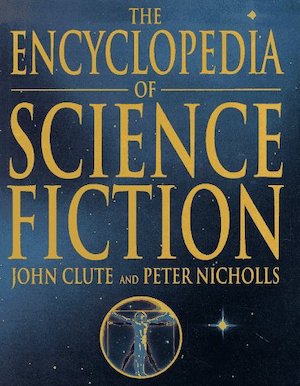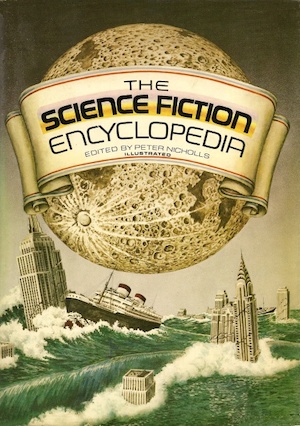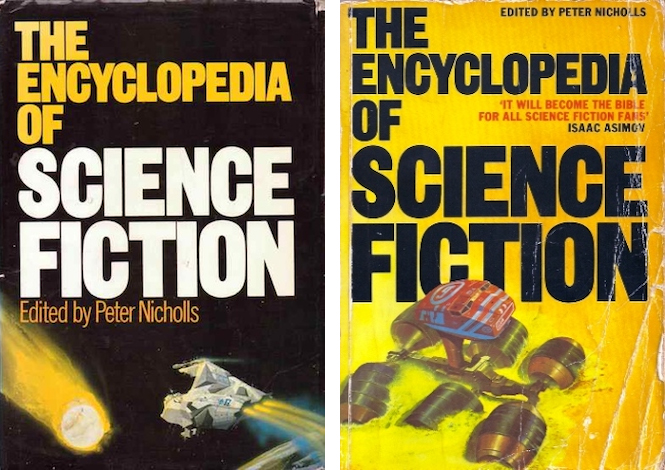Imagine, if you will, a dark age in which information was not at the tip of one’s fingertips, in which acquiring it required a trip to the library or the bookstore, in which tidbits of useful information might be limited to brief introductions and afterwords, in which there was no guarantee that the information would exist in an accessible form anywhere at all. Imagine further that one was a snoopy highly inquisitive young reader, curious about the authors whose works he was consuming and eager to know more about the works themselves. Imagine the frustration.
Imagine, then, the glee that resulted when The Encyclopedia of Science Fiction: An Illustrated A to Z (or as it was known in the edition I had, The Science Fiction Encyclopedia) appeared in 1979.
It was Peter Nicholls’ brainchild, but the work required a substantial team to turn the dream into a 672-page tome. Nicholls served as the general editor, with John Clute as associate editor, Carolyn Eardley as technical editor, and Malcolm Edwards and Brian Stableford as contributing editors. A team of ancillary experts provided further help. The encyclopedia held close to 3600 cross-referenced entries, covering authors, themes, and much more. The total word count? Some three quarters of a million words.
You might think “Oh, almost a million words? Why, that’s barely a single installment of A Song of Ice and Fire!” But consider that in the mid-to-late 1970s, most people did not have access to computers. The SFE’s 3600 entries were hammered out on typewriters. Possibly *manual* typewriters.
Nicholls and Clute produced a second edition in 1993.

This new version was almost twice as long as the first (more time to add entries and of course the field had expanded greatly between 1979 and 1993). A CD-ROM edition followed in 1995—do I need to explain CD-ROMs? They’re like a higher density phonograph—itself filled with material the earlier editions lack. In addition, 1997’s The Encyclopedia of Fantasy edited by John Clute and John Grant did for fantasy what the SFE did for SF.
The Third Edition contains in excess of 18,000 entries and almost six million words. Unlike the previous edition, the current SFE is online, and may be found here. As an extra bonus, entries on many books have links where said books may be purchased, which of course would not lead to impulse buying. Because we are all so self-disciplined, right?
There had been other sourcebooks on science fiction, but nothing with the breadth and detail of the SFE. No doubt there were errors. Moreover, due to limits on staff and staff hours, and due also to printing constraints (the finished product had to be appreciably smaller than a Galilean moon) not every possible subject could be covered and those that were sometimes covered very briefly. Even taking all of that into account, though, no other contemporary work compared to that wonderful 1979 edition. In an age before the World Wide Web, it was the go-to source for SF information.

To a person of a certain bent of mind, the SFE was pure delight (on par with the CRC Handbook of Physics and Chemistry). Hours—nay, days!—could be lost simply by looking up a single entry, then getting drawn into references to other entries. Today we’re spoiled for sources (although perhaps not so spoiled when it comes to reliable sources) but even forty-one years later, I feel an endorphin rush as I remember reading through the SFE cover to cover for the first time.
In the words of Wikipedia editor TexasAndroid, prolific book reviewer and perennial Darwin Award nominee James Davis Nicoll is of “questionable notability.” His work has appeared in Publishers Weekly and Romantic Times as well as on his own websites, James Nicoll Reviews and Young People Read Old SFF (where he is assisted by editor Karen Lofstrom and web person Adrienne L. Travis). He is currently a finalist for the 2020 Best Fan Writer Hugo Award and is surprisingly flammable.










